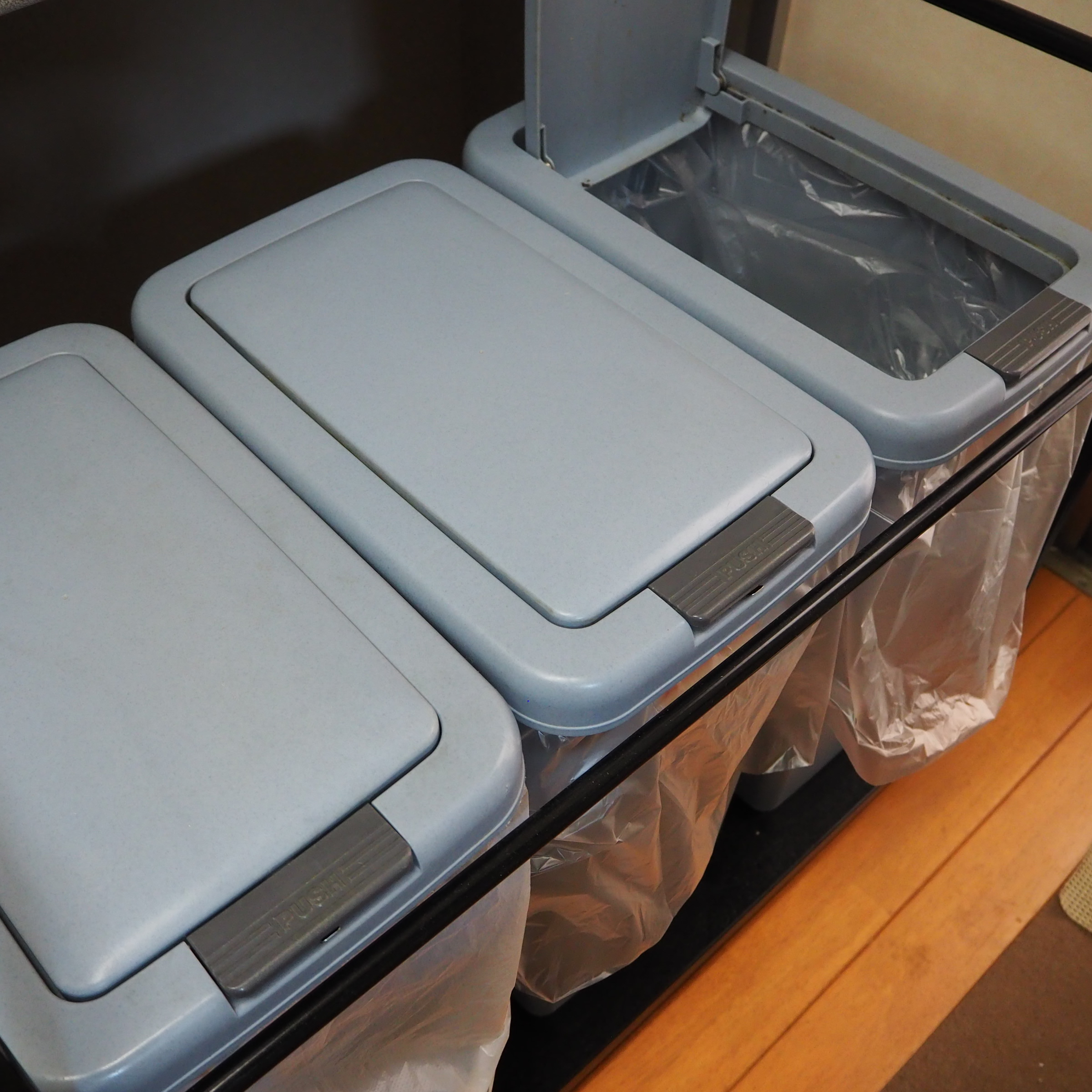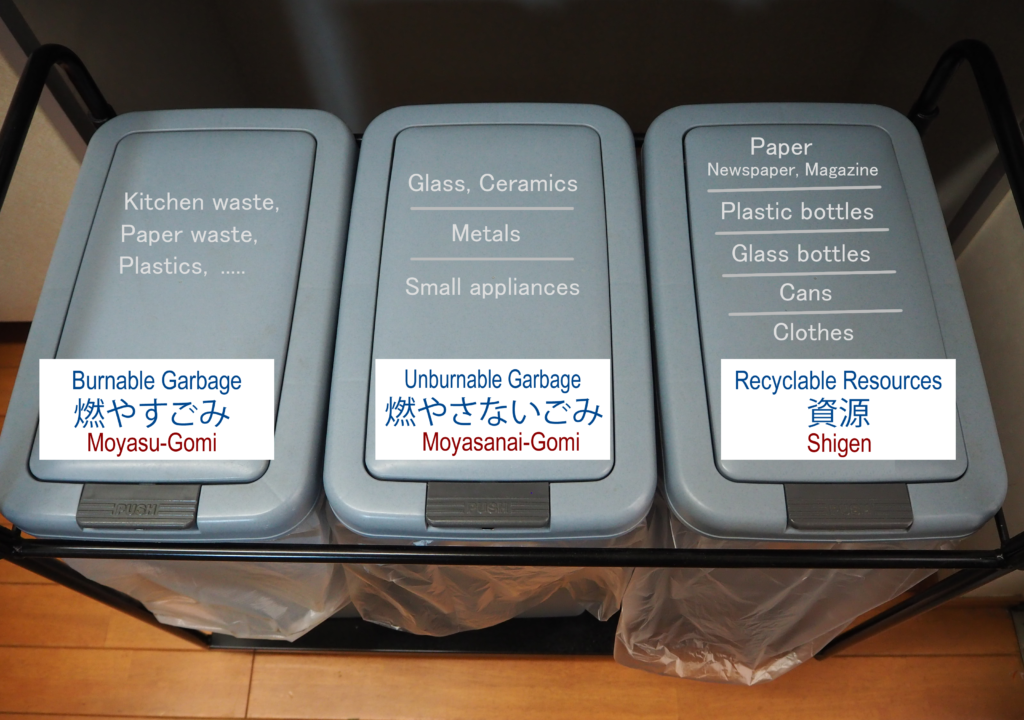Sorting household waste into four categories; Burnable, Unburnable, Recyclable, and Oversized garbage, is commonly instructed in any areas of Japan. In addition to sort by categories, local municipalities also instruct sorting by items in accordance with their own rules. To find details on how to properly separate waste in your town, you need to refer to the information distributed at your local municipal office. In terms of the basic rules to follow in any places in Japan (Tokyo and the vicinity), here you will find the information in this article. Also, the information on how to put out waste can be found on the page “How to dispose of household waste – Part 1.”
Sorting household waste
Burnable garbage
燃やすごみ (Moyasu-Gomi) or 燃えるごみ(Moeru-Gomi)
Types of Burnable waste
Kitchen scraps (生ごみ Namagomi), Paper scraps (紙くず Kamikuzu), Plastic items (容器包装プラスチック Youki, Hoso Plastic), Clothes, Cloth (衣類 Irui), Rubber (ゴム類 Gomu-rui), Leather (皮革類 Hikaku-rui)
It is advisable that you select burnable waste carefully as most of them can be recyclable.
The size of burnable garbage is regulated, usually must be within 30cm square. The larger burnable waste is disposed of as oversized garbage or Sodai-Gomi.
Examples: Burnable garbage
To find detailed information, see the website of local municipalities (from the external links at below in this page).
- Instant ramen container
- Disposable containers of bento lunch boxes and delicatessen bought at convenience stores.
- Shampoo bottles
- SD cards: Cut into pieces for security purpose
- CD, videotapes
- Diapers: Clean before disposing of
- Seashells
- Ice packs
- Aluminum foil
- Tissue paper: Toilet gets clogged if you flush tissue paper
- Wood branches: Cut into about 30cm, then bundle with a string.
- Sneakers, leather shoes
- Cooking oil: Frying oil for Tempura etc. Use an oil coagulant or paper to soak it up.
- Skewers of Yakitori grilled chicken: Care should be taken for not to stuck them (anything sharp) out from the garbage bag.
- Ski boots: Remove metal parts. If you cannot remove them, the boot is to be disposed of as unburnable garbage.
- Bicycle tires and tubes
Bags Remove metal parts. The bags larger than max allowable size are taken as oversized garbage.
Unburnable garbage
燃やさないごみ (Moyasanai-Gomi) or 燃えないごみ (Moenai-Gomi)
Types of Unburnable waste
Broken glass (壊れたガラス Kowareta Garasu), potteries (陶磁器 Toujiki), metals (金属類 Kinzoku-rui), small electronic appliances (小型電化製品 Kogata Denka-seihin)
Small electric appliances are sorted as unburnable garbage, which you can put out at the collection point on the designated day to be collected by a garbage truck. The collected appliances are disassembled so that some of the parts inside can be recycled. As for small devices, such as mobile phones and digital cameras that contain precious metal components, are sorted as recyclable waste.
In order to guard the collector’s fingers, broken glasses must be wrapped with paper (e.g., newspaper) and indicated “Danger (キケン Kiken)” by writing on it.
Examples: Unburnable garbage
To find detailed information, see the website of local municipalities (from the external links below on this page).
- Light bulbs: For safety, pack in a bag when putting out.
- Umbrellas
- Knives, razors: Wrap with paper and put “Danger (キケンKiken)” by writing on it.
- CD Players: The size must be within 30cm square.
- Disposable heating pads (Tsukaisute Kairo): In some cities sorted as burnable waste. Ask at your local municipal office for information.
- USB sticks: Erase any personal information in the USB with an elimination software, or physically destroy it before putting out.
- Rice cookers
- Nail polish bottles
- Paint cans, oil cans
- Lighters: Must be used up before disposing of.
- Mercury thermometers: Any items containing mercury must be disposed of as unburnable waste.
- Dry cell batteries, Coin batteries (Rechargeable batteries and button batteries (containing mercury) are collected by the manufacturers or at retail stores.
Recyclable garbage
資源(Shigen)
Types of Recyclable resources
Paper (古紙 Koshi), Bottles (びん Bin), Cans (缶 Kan), Clothes (衣類 Irui), Produces containing precious metals (希少金属が使用されている製品 Kisho-Kinzoku)
The items collected as recyclable garbage may vary depending on the local municipalities. Some cities also have rules to sort the items precisely into five kinds or more. To find more detailed information, ask at your local municipal office.
As with other types of waste, recyclable garbage is also put out at a designated place to be collected by a garbage truck. Plastic bottles and milk carton boxes are usually collected at supermarkets or public facilities, such as community centers, where you will find the collection boxes.
Electric devices including precious metals; mobile phones and digital cameras, are collected at mobile phone shops or local municipal offices where you will find the collection boxes. (Erase any data when disposing of mobile phones.)
Glass bottle deposit-return system is not popular in Japan. You will not get a refund even if you return empty bottles to a supermarket or convenience store. However, liquor shops may return you a deposit.
Electric appliance stores provide a collection box for rechargeable batteries and button batteries (containing mercury).
Resources/ Recyclables
To find detailed information, see the website of local municipalities (from the external links below on this page).
- Plastic bottles: Remove caps and labels and clean the inside
- Newspapers, Flyers: Bundle and tie with a string
- Magazines: Bundle and tie with a string
- Carton boxes: Flatten, bundle and tie with a string
- Milk carton boxes: Clean inside and flatten to dry
- Tissue paper boxes: Remove the plastic part
- Candy boxes and wrapping paper
- Wine bottles
- Cosmetic bottles: Broken bottles and oil bottles are not collected as a recyclable waste
- Beverage cans
- Bug spray cans: Must be used up before disposing of Gas cartridges: Must be used up before disposing of Beverage bottles
Oversized garbage
粗大ごみ (Sodai-Gomi)
Household garbage over 30cm in height/width, such as drawer chests, mattress, and suitcases, are disposed of as oversized waste or Sodai-Gomi, collected with a fee.
In the case of Tokyo municipalities, oversized garbage is collected on request. If you need to dispose of your oversize waste, you are to contact Bulky Waste Reception Center (粗大ごみ受付センター Sodai-Gomi Uketsuke Center) to request for the collection. The application is accepted both on the telephone or the internet. Contacting online will be better as their website is available in foreign languages; English, Chinese, and Korean, as well as Japanese.
The collection fee is paid by purchasing tickets (labels) called ” Sodai-Gomi Shoriken 粗大ごみ処理券)” or bulky waste tickets. If you send a request for collection, you will receive instructions for when and where to put out your garbage (Usually front of the property if its an independent house.), and the number of tickets to be required. You can purchase the tickets at a nearby store accordingly, then put the tickets (labels) on the garbage and take it out to the designated place.
Bulky Waste Reception Center粗大ごみ受付センター
https://sodai.tokyokankyo.or.jp/
Large electric appliances cannot be handled as oversized waste
The items specified in the Electric Appliance Recycling Law; air-conditioners, TVs, refrigerators, freezers, washers, and dryers, are not allowed to dispose of as oversized waste. To dispose of these items, you need to ask the retailer or a recycler for collection.
The disposal fee of large electric appliances comprises of recycling fee and collection/handling fees. The rate of recycling fees is set differently by manufactures, and the collection fee varies depending on the retailers. As a rule of thumb, the recycling fee of a washing machine may be 2300 JP Yen on average, and the amount of disposal fee by adding the collection/handling fee will be somewhere between 3000 and 6000 JP Yen.
There are two options as a disposal method (Example: Washing machine)
In the case of replacement when buying a new washer: 買い替えKaikae replacement
If you buy a new washer at a retail store and request for the installation, you can have the old washer replaced and collected at that time, which is called Hikitori Pickup. Hikitori may allow you to get some discounts for collection/handling service fees.
In the case of disposing of an unnecessary washer: 廃棄処分 Haiki Shobun
If you need to dispose of your washer, when moving out or leaving from Japan, you may contact the retailer and request for collection. The collection/handling fee will be higher compared with Kaikae replacement.
If you are unsure of where the washer was purchased at, search for a private disposal company and ask for collection. Though you can find those companies on the internet, most of their services are available in Japanese. (As of 2019 June). It is suggested you contact your local municipal office and ask for advice. If the washer is still good in use, selling to a second-hand store will be another option.
Personal Computer Recycling System
Personal computers are also not disposed of as oversized waste. You need to ask the manufacturing company for collection with a fee. The rate varies depending on the companies, will be 3000 JPY or more for collecting a desk-top PC. One thing you should know is that free-collection services are also available from the recycling companies designated by the local government. Applying on the recycler’s website, you are instructed to pack the PC in a carton box and send it by parcel delivery service. There are some recyclers who will pay the delivery fee for you. In any case, be sure and erase any of the data in the PC with an elimination software before sending it.
Information by local municipals
To find detailed information on garbage sorting, see the website of local municipals (external links)
Tokyo (Special wards) 東京都(23区内)
Chiyoda City 千代田区
Minato City 港区
Shibuya City 渋谷区
Shinjuku City 新宿区
Shinagawa City 品川区
Meguro City 目黒区
Setagaya City 世田谷区
Ota City 大田区
Kanagawa Prefecture 神奈川県
Kawasaki City 川崎市
Yokohama City 横浜市



